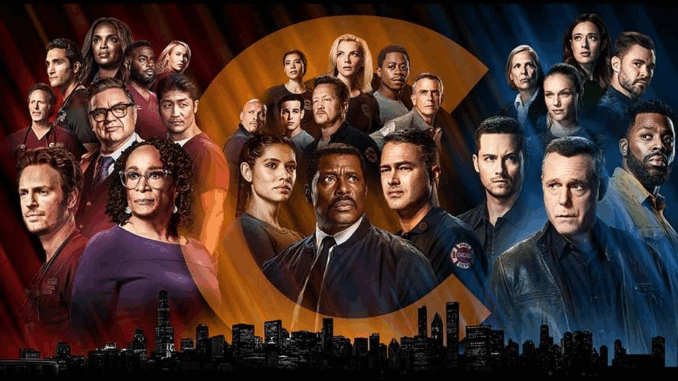
For over a decade, NBC’s Chicago Fire has reigned as the undeniable flagship of Dick Wolf’s expansive One Chicago universe. While the series delivers the pulse-pounding action of high-stakes rescues and blazing infernos, its enduring appeal doesn’t lie solely in the procedural thrills. It’s found in the intricate, emotional tapestry woven between the professional dangers of firefighting and the deep, personal bonds of camaraderie that form the heart of Firehouse 51.
Chicago Fire masterfully distinguishes itself by balancing the dramatic intensity of its rescues with the raw, relatable weight of everyday pressures—from relationship turmoil and personal ambition to the struggles of parenthood and the shadow of past trauma. This blend of adrenaline-fueled action and grounded emotional reality is the secret formula that has turned the members of Truck 81, Squad 3, and Ambulance 61 into household names and genuine television heroes.
🤝 Camaraderie: The Unspoken Code of Firehouse 51
In the world of firefighting, camaraderie isn’t a perk of the job—it’s an essential survival tool. Chicago Fire elevates this professional necessity into a profound familial structure, creating a sanctuary where trust is absolute and loyalty is unconditional.
The Firehouse Family
The members of Firehouse 51, led by the stoic wisdom of Chief Wallace Boden (Eamonn Walker), operate not as colleagues but as an extended, often dysfunctional, family.
- Trust on the Line: In a burning building, every life depends on the person beside you. The show brilliantly illustrates how the constant proximity to death forges unbreakable bonds. When Lieutenant Kelly Severide (Taylor Kinney) trusts Joe Cruz (Joe Minoso) with his life on a rescue, that trust extends far beyond the fireground, manifesting in shared meals, personal advice, and deep, lifelong support.
- The Shared Table: The firehouse kitchen table is perhaps the most iconic location in the series. It’s where the most honest conversations happen, where personal problems are aired, and where the communal, supportive nature of the job is physically demonstrated. This ritual reinforces the theme that they face life’s pressures together, whether those pressures come from a burning warehouse or a struggling business venture (like Christopher Herrmann’s Molly’s bar).
- Healing the Trauma: Firefighters witness unspeakable tragedy. The ability to process this trauma rests heavily on the support of their team. Chicago Fire frequently shows characters supporting one another through grief, anxiety, and PTSD, highlighting that the true job of a firefighter often involves rescuing their own.
This profound sense of family is the reason fans tune in; they are invested not just in the fires, but in the survival of this core unit against all odds.
🏃 Everyday Pressures: The Grounded Reality
What makes the heroes of Firehouse 51 relatable isn’t their ability to brave flames, but their struggle to manage their high-risk careers alongside the mundane, messy reality of everyday life.
Relationship Turmoil and Sacrifice
The pressures of the job on personal relationships are a constant, heavy theme.
- Stellaride’s Struggle: The dynamic between Severide and Lieutenant Stella Kidd (Miranda Rae Mayo) perfectly encapsulates this pressure. Their marriage, affectionately dubbed “Stellaride,” is constantly tested by Severide’s impulsive need to pursue high-risk arson investigations and Kidd’s struggle to balance her career ambitions (Girls on Fire, Lieutenant duties) with her family life. Their long-distance struggles serve as a painful reminder that the job demands sacrifices that regular relationships don’t face.
- Ambulance 61’s Heartbreak: The Paramedics, like Violet Mikami (Hanako Greensmith), carry a unique burden: they are often the first on the scene, dealing directly with victims and their families. This emotional weight bleeds into their personal lives, making simple relationships difficult to sustain when they are constantly dealing with life-and-death stakes.
Parenting and Legacy
For characters like Herrmann and Boden, the pressure of parenthood is magnified by the constant risk.
- The Call Home: Every time they leave for a shift, there is a very real chance they won’t come home. This creates an emotional tension that is explored through their dedication to providing for their families while grappling with the possibility of leaving them behind.
- The Pressure of Promotion: Characters like Lieutenant Matthew Casey (Jesse Spencer) and Kidd face the pressure of advancing their careers without sacrificing the relationships that matter most, proving that the struggle for professional growth is often a central, relatable conflict.
⚖️ The Balanced Recipe: Adrenaline vs. Authenticity
The success of Chicago Fire lies in the delicate equilibrium it maintains between its two core ingredients: the high-octane action and the authentic human drama.
- The Procedural Hook: The show never lets viewers forget the intensity of firefighting. The technical details of rescue, the danger of backdrafts, and the coordinated efforts of the team keep the procedural hook sharp, drawing in action fans.
- The Emotional Anchor: Immediately following a life-threatening rescue, the show pivots back to the quiet moments—a conversation in the shower room, a sigh in the office, or a drink at Molly’s. These moments remind the audience that these heroes are just ordinary people dealing with extraordinary stress. This authenticity keeps the audience emotionally invested and grounded.
This unique recipe has not only maintained the show’s popularity but has enabled the creation of the One Chicago crossover events, where the emotional stakes of the firefighters seamlessly merge with the criminal investigations of Chicago P.D. and the medical emergencies of Chicago Med.
🔑 Conclusion: The Enduring Flame of Firehouse 51
Chicago Fire continues to resonate with audiences because it doesn’t just show us heroes—it shows us humans under pressure. The enduring appeal lies in the powerful, unbreakable camaraderie that provides a necessary emotional lifeline against the backdrop of constant danger.
By forcing its characters to navigate explosive rescues and the quiet, crushing weight of everyday pressures—like love, ambition, and trauma—the show creates a deeply relatable experience. Firehouse 51 isn’t just a workplace; it’s a family built on shared risk, shared tears, and shared triumphs. It is this emotional honesty, more than any roaring blaze, that keeps the flame of Chicago Fire burning strong.
